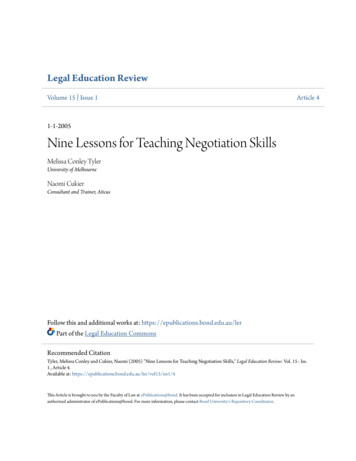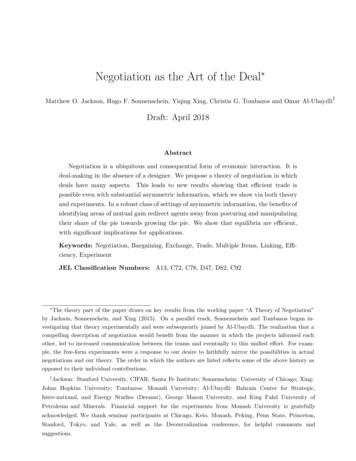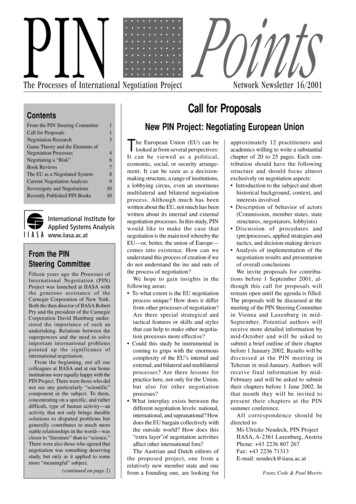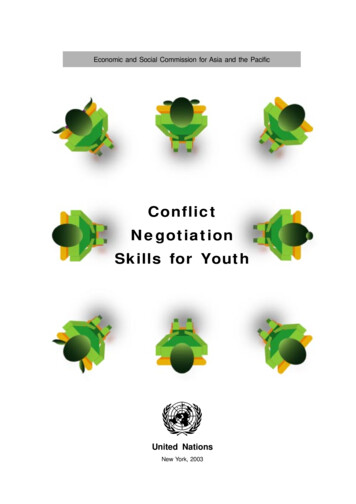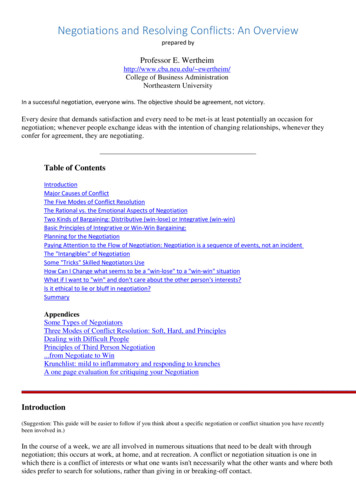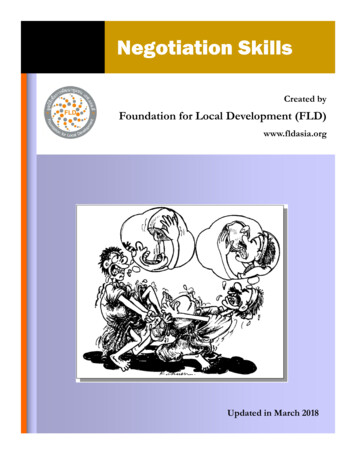
Transcription
Negotiation SkillsCreated byFoundation for Local Development (FLD)www.fldasia.orgUpdated in March 2018
Negotiation SkillsAbout this manualThis manual is to be used as either: Student manual (for self-study) Student manual for a participant to a workshop who wish to learn further Trainer manual for a workshop facilitatorTable of Contents:Chapter 1. Are you Ready to Negotiate?4Introduction4Additional examples, Analysis Toolkit and Case Study5Chapter 2. Understanding Negotiation8Introduction8Preparing for Negotiation8Thinking Deeply about Negotiation10Determine Needs and Wants11Map the Negotiation12Plan for the Outcomes of the Negotiation13Using Principled Negotiation15Separate the People from the Problem17Focus on Interests, not Positions20Develop Options for Mutual Gain23Use Objective Criteria2532
Negotiation SkillsChapter 3. Conducting Successful Negotiations27Introduction27Creating the Non-Verbal Environment27Starting the Negotiation29Appropriate Language for the Negotiation30Effective Responding and Listening Techniques31Chapter 4. Conflict Resolution35Introduction35Negotiation Styles35Dealing with Conflict38Achieving a Negotiated Outcome39Evaluating the Negotiation41Evaluate Yourself as a Negotiator42Annex A : Negotiator’s Analysis Toolkit43Activities Workbook50
Negotiation Skills 4Chapter 1 - Are you ready to negotiate?Chapter 1 – Are you ready to negotiate?Learning Outcome:Developing specific skills needed for successful negotiationAfter completing this topic you will be able to: understand what negotiation is identify the necessary skills for successful negotiationIntroductiono What is negotiation?o Have you ever discussed who should wash the dishes?o Have you ever tried to organise a time for a meeting when everyonecould attend?o Have you ever discussed the price you wanted to pay for an item, ordiscussed how much money you should spend on something?o Have you ever tried to organise extra time to complete a job?If you answered yes to any of these questions, you have already beeninvolved in negotiating. All of these situations involve elements ofnegotiation. They become more or less complicated depending on theresponses of the other people involved.A negotiation is an interpersonal communication that involves two or more people who each have goals they wish toachieve and where these goals require the cooperation of the otherperson.Negotiation is the process that is used to achieve agreement about theoutcome of the situation.In all areas of our lives - family, work, and community - we negotiate inorder to obtain goods, services, and opportunities that we need or want.For example, we may negotiate when we buy a motorbike in order to get
Negotiation Skills 5Chapter 1 - Are you ready to negotiate?it at a price we can afford. Or, we may negotiate over the opportunity totake on a new project or position at work.The potential for conflict exists in all situations where we negotiate.Successful negotiation involves knowing how to manage potential andreal conflicts. To do this, you need skills to recognise the signs andcauses of conflict. You also need to be able to use strategies to deal withany conflict.There are many techniques that people use when negotiating. You willencounter these when you analyse, observe, and participate in anegotiation.Additional Examples, Analysis Toolkit and Case StudyAdditional ExamplesThroughout this module you will find several sections titled “Additional material”and “For Example ”Take a moment to study each of these, by either reading the material under theheading or by visiting the link which has been provided.During this module it is critical that you constantly refer to Annex A:Negotiator’s Analysis Toolkit. This toolkit contain some extra skillsneeded for understanding the module.Negotiation skills case studyThroughout this module, you will be asked to complete a range of activitiesso that you can practice your learning. A case study about a workplacenegotiation at Education Materials (EM) is presented to provide you with acase to think about through all the stages of negotiation. You will bereferringtoarethisthecasestudythroughoutthe module for many activities.BelowEMcasestudy details:EM produces educational publications dealing withlanguage teaching, community health and agriculture.The Language Department, Health Department andAgriculture Department are each headed by aManager. EM has a number of regional offices, mainlyresponsible for sales and supervised by RegionalSupervisors. The Administrator has two Administrative
Negotiation Skills 6Chapter 1 - Are you ready to negotiate?Assistants. There are Sales Staff based in the regional offices. A numberof Materials Development Officers work in the head office developing newmaterials for publication.You have been given responsibility as Administrator for a particularchange in working conditions being introduced in the workplace.One of the funders providing a grant to EM requires that EM implementan effective system for regulating the amount of time worked by eachemployee. This is a normal practice in the workplace designed to protectemployees from exploitation. The system will be applied to the timeworked and leave (time-off) for all employees.Because EM started very small and many staff were volunteers, until nowEM has used an informal system where all employees are expected towork hard, often involving long hours. The work is seen as ‘for thebenefit of the community’. When employees need time off, they justtake it and inform the other staff they work with why they need time off.The new system will make clear which days are to be regarded as officialpublic holidays, what hours the employees are expected to work duringwork-days, and how much time off they may take for various reasons,e.g. because of sickness, for annual holidays etc.Some of the staff have been with EM a long time and have never takenany annual holidays. Others have only recently started work. Someworkers have been allowed to take many days off for ‘family reasons.As the Administrator, you will have to be involved in a range ofnegotiation situations to successfully manage the change. The processinvolves: informing the staff about the new system organising the introduction of the new system, including making sure that management makes clear rules about the requireddaily work hours how much leave the staff are allowed each month or per year worked, having all the staff fill in time sheets for time worked, making applications to their supervisor when they want to take leave, organising administrative staff to record time worked and leave takenby each staff member,
Negotiation Skills 7Chapter 1 - Are you ready to negotiate? making decisions about how much leave each employee has owing tothem through the work they have done in the past and the leave theyhave taken in the past (which was never officially recorded!), making sure that the new system is working successfullyIt is not your job to set the rules concerning the actual hours to beworked and the amount of leave to be permitted (that is theresponsibility of the management team, of which you are a part).However, it is your job to achieve a successful transition from thecurrent system to the new one.Some of the things that you will have to manage include: deciding what information the staff needs to know about the newsystem establishing time lines for the introduction of the new system, andwhich staff will administer the system agreeing on a process with the management team for theestablishment of the rules for the new system.In these situations, you will need to negotiate with one or more parties inorder to achieve a successful outcome for yourself, for EM and forachieving a successful introduction of the new system.Throughout the module the EM case study will focus on a range ofsituations that will require negotiation by you, the Administrator. Thecase study will involve people in a range of different jobs, such asDepartment Managers, Administrative Assistants, Materials DevelopmentOfficers, Regional Supervisors, and Sales Staff. You will need to considereach individuals personality when conducting your negotiations.Finally, the EM case study will consider ways that you can evaluate thesuccess of the negotiation process. The more you can relate the casestudy activities to your actual life experiences, the more it will be usefulto you as a learning tool.We are now ready to take an even closer look at the art and the scienceof negotiation.
Negotiation Skills 8Chapter 2 - Understanding NegotiationChapter 2 Understanding NegotiationLearning Outcomes: Planning for and analyzing the components of a negotiationUnderstanding the concept of principled negotiationAfter completing this topic you will be able to:-prepare for a negotiation by identifying the actors,problems, goals, needs and concerns.prepare a map for your planned negotiation and think abouta wide range of possible outcomesunderstand how to use principled negotiation and its fourkey ideasIntroductionThis Chapter will introduce you to skills for planning an effective andsuccessful negotiation. It will discuss how to: consider the issues and goals of the negotiation assess your needs and the needs of the other parties consider some of the processes that can be used for conductingnegotiations learn to plan for a range of outcomesIn addition you will learn the concept of principled negotiation andhow this differs from positional negotiation.The four main points of principled negotiation are stated as: people,interests, options, and criteria. These points are what make principlednegotiation an effective method which can be used under almost anycircumstance.Preparing for negotiationThe preparation stage is essential to the successful outcome of anynegotiation. It is important that you consider all the key points ofpreparation, and that you put time and effort into this stage.Although we will look in depth at preparing for negotiation throughoutthis Chapter, the basic steps are:
Negotiation Skills 9Chapter 2 - Understanding NegotiationAnalyse the negotiation What is the problem? What are the goals? What are the issues?Assess the people involved Who are they? What do they see as the problems? How do they feel about the issues? What are the relationships that need to be considered?Record the facts What information is known? What is the context for the negotiation? What outcomes are possible? What action is needed to set up the negotiation?Additional material:We must think comprehensively about the negotiation which we are about to undertakeif we are going to be successful. It is not enough to think only about one or two points –we must prepare for our negotiation by thinking about all of the above questions.The following talk by Alain Lempereur, Professor at the ESSEC Business School in France,discusses the key points we must think about in a negotiation: the People, the Problem,and the Process. This material helps you understand just how much work you should dobefore the negotiation even begins.“But there is so much!” you are saying! “How could we possibly think about all that?”Well, everything that Alain has discussed will be taught in the following pages. Byworking through the information, exercises and case studies carefully, you too will learnhow to effectively prepare for negotiations.Click HERE.Activity 2.1 Case Study
Negotiation Skills 10Chapter 2 - Understanding NegotiationThinking deeply about negotiationTo be effective negotiators we must think about the negotiation deeply.The following sections help you to do this.Remember to use empathy at all times. Empathyis what helps you understand the situation fromthe perspective of the others involved. You areusing empathy when you “put yourself in theothers’ place."Identify the problemWhen you identify the problem in a negotiation,attempt to describe the overall issue that iscausing concern.You should not try to develop a statement of right and wrong, or astatement of positions that each side will take. But try to anticipate whatproblems the negotiators might face.It is important to focus on these potential problems while you areplanning. The issues should be your main concern rather than thedifferent views of the involved parties.Define the goalThe goal is not a statement of possible solutions.It is designed to provide a focus for the negotiation.Stating your goal in anegotiation means making astatement about the bestoutcome that you can achievein the situation. The goalshould tell us the mainsubstance of the negotiation:“Why are we having thisnegotiation?”
Negotiation Skills 11Chapter 2 - Understanding NegotiationDefining your goal will help you: Think about what you want and what you are prepared to give inreturnKeep a clear focus during planning and negotiationAvoid being distracted or confused by issues that other parties will useShow from the start of the negotiation that you are clear about whatyou wantThink about the goals of others and anticipate themRemember, your goals do not have to be fixed forever; they can alwaysbe changed.When planning for a negotiation and identifying the goal, or outcome tobe achieved, it is important to consider your relationship with the othersinvolved. If you will continue to relate with and work with them in thefuture, this will be an important factor in setting your goals. If, however,you will not relate with that person again you might be prepared to betougher in the negotiation. Other factors like time and cost will alsoinfluence negotiations.Activity 2.2. Case StudyActivity2.2 Case StudyDetermine needs and wantsNeeds are essential to account for in the negotiation process – our needsfor goods, services, and opportunities are usually the main reason whywe are planning to negotiate.An essential process in conducting successful negotiations is to provideopportunities to identify your own needs and the needs of the otherparties through discussion.Our attitudes, actions, and values that we demonstrate duringnegotiation are based upon our needs. Our willingness to negotiatedepends on how important our needs are in the negotiation.It may not be easy for you to focus on your own needs because we oftenexpress our needs as wants.We say what we want to gain, without stating why. The reason why isusually a more accurate statement of our needs.For example:when you ask to leave work early, what you want is timeoff work. But why do you want that time off? Your supervisor has a
Negotiation Skills 12Chapter 2 - Understanding Negotiationbetter chance of understanding the request for time off if the need isstated too. For example, if you need time off to go to an importantappointment with your doctor, your supervisor is more likely to give youthe time off if you make this need known.Finding out the needs of people in a negotiation allows both parties toconsider a wider range of outcomes.Here are some of the tools that you can use to collect information aboutthe needs and wants of the parties involved (make sure to look at thedetails of each in Annex A: Negotiator’s Analysis Toolkit): SWOT analysis"Must / should / could get” chartThese tools will help you to identify the range of issues, needs, options,goals, and facts relevant to the particular negotiation. These tools couldassist you to collect and assemble the facts and information about thenegotiation, the context, and the people involved. You can also usethese tools to help you consider the needs and wants of theparties involved. Once this information has been collected, then youneed to use the facts to map out the negotiation.A successful negotiator is always fully informed and prepared beforestarting to the negotiationActivity 2.3 Case StudyMap the negotiationFrom collecting and understanding the facts above you are now able tomake a negotiation ‘map’ (see the example below). In this case thechart helps us to be clear about the needs and concerns of both partiesat EM. In the upper section are the needs and concerns of themanagement at EM, and in the lower section those of the staff. Whenmapping your own negotiation you must do this for all the peopleinvolved.
Negotiation Skills 13Chapter 2 - Understanding NegotiationManagement Needssuccessful management of projectsatisfied staffmaintain good communicationswith workerswork-time system in operationself-esteem enhancedConcernsanger from supervisorsdiscontent from staffblame if system does notwork Staff Needsadequate allowance made for hardwork in pasttime for trainingconfidence that the new system willbe "fair".clear definition of who will beresponsible for calculating staff leave. Concernsmay lose leave that was earnedbefore new system introducedwork- place will become bureaucratic("Bureaucratic" refer to thingsworking strictly according toregulations rather than on the basisof personal interactions.)filling in time-sheets will waste timeclerical staff will have more work todoPlan for the outcomes of the negotiationThe types of outcomeIt is also helpful to think about the outcome of the planned negotiation.There are three ways to describe the possible outcomes of a negotiation:a win/lose outcome, a lose/lose outcome and a win/win outcome.(Please refer to the Outcome Matrix in Annex A: Negotiator’s AnalysisToolkit.)In a win/lose situation only one person has achieved an outcome that issatisfactory. The goals of the other party are not achieved. This resultsin on-going conflict and resentment. It is an unbalanced outcome andmay require more negotiation in the future.
Negotiation Skills 14Chapter 2 - Understanding NegotiationA different situation occurs when neither person nor side achieves asuccessful outcome. This is described as a lose/lose outcome, sinceboth sides are left unhappy. This may result in bad feelings, disruptionsto relationships, and more negotiation in the future.The preferred end point for a negotiation is one that achieves an agreedoutcome. This is described as a win/win outcome. In this scenario, thegoals of all parties are reached. There is two-way communication, andno resentment. This outcome produces the best long-term solution, andmaintains satisfactory working relationships between the peopleinvolved.A win/win outcome should be part of the goal of any negotiation. Thegoal that you identify should address both the needs of the other parties,as well as your own needs. Part of your goal in the negotiation willbe to convince the other parties that it is in everyone’s bestinterests to achieve a win-win solution.Thinking aheadThe effective negotiator has always thought about a wide range ofpossible outcomes before ever beginning the negotiation. This is a keypart of being fully prepared. To do this brain-storming is very useful.The theory behind brainstorming is that the ideasfrom each person in thegroup will generate more creative thinking from others. Or, if you areworking alone, it encourages your brain to think more creatively. Hereare two approaches to brain-storming which you can use:Brain-storming refers to a process of puttingdown in writing immediate ideas occurring inrelation to a particular issue or problem.To conduct an unstructured brain-storming session, your group willneed to set a fixed time limit (usually between three and five minutes).Each member of the group will need a paper and pen to record ideas.When the time starts, each member writes down all of the ideas they canthink of that are related to the issue. During the brainstorming time, allof the ideas are accepted. Later on, through discussion, the group candecide what ideas are the most useful and which ideas turned out to benot useful and can be rejected.Or, we can use the PMI (Plus, Minus, Interesting) technique. Thisapproach uses the same method as above, but three timed sessions are
Negotiation Skills 15Chapter 2 - Understanding Negotiationused. In the first session, only positive ideas about the topic are stated(Plus). In the second session, negative ideas are stated (Minus). In thethird, points of interest about the topic are stated (Interesting). Theseare recorded in three separate lists. All ideas should be recorded, anddiscussed by the group. Please refer to Annex A: Negotiator’sAnalysis Toolkit for an example of a PMI chart.Activity 2.4 Case StudyUsing principled negotiationTraditional models of negotiation are based on adopting a clear position,and then bargaining with others so that they give in or compromise withyou. This is called positional bargaining.Using this approach, the parties pay moreattention to justifying their positions (i.e.arguing why they should get what theywant) and less to addressing the real issues.A good example of this style of negotiating isthe bargaining that takes place between ashopkeeper and a customer, when the shopkeeper knows how little the profit margin isand the customer is aware of how small thebudget is and has a fixed 'top' price. Perhapsthey will reach an agreement; perhaps not.Positional bargaining negotiating can be approached using “hard” or“soft” negotiation styles. The hard approach is used when therelationship between the parties is seen as important, the soft approachwhen it is not. But once each side has taken a position, they are usuallyvery unwilling to make concessions. Concession is the word used to referto what one side or the other gives way on or 'concedes' to the otherside. The outcome will be win/lose, or no agreement at all.Principled negotiation removes the need to choose between the hardand the soft approaches. Principled negotiation starts with the needsand interests of the people involved in the negotiation. Its final aim is toachieve a mutually acceptable outcome, or as this is described above, awin/win outcome. To understand in greater depth how this differs from
Negotiation Skills 16Chapter 2 - Understanding Negotiationpositional bargaining please refer to the Positional Bargaining VersusPrincipled Negotiation in Annex A: Negotiator’s Analysis Toolkit.The principled approach is based on four key ideas:1. Separate the people from the problem2. Focus on the interests, not the positions3. Develop options for mutual gain4. Insist that results are based on an objective standardAny negotiation may be judged by the following three criteria:1. Did the negotiation reach a wise agreement whenever agreement waspossible?2. Was the negotiation efficient?3. Did the negotiation improve (or at least, not damage) the relationshipbetween the parties?Consider the following additional questions when working with aprincipled negotiation style: Is there ever a situation where positional bargaining makes sense?What if the other side believes in positional bargaining, and you believein principled negotiation?Should you be fair, even if you don’t have to be?Additional material:The following video is a short introduction to negotiation, includingprincipled negotiation. What is it? Why is it important? How does it happen?It also introduces us to the idea that negotiations are processes of dialoguebetween stakeholders (in other words people talking to each other), and thedifferent types of people in negotiations.Take a moment to watch it. But don’t worry if you cannot understand all of theinformation– we will visit each point again later!Click HERE.
Negotiation Skills 17Chapter 2 - Understanding NegotiationSeparate the people from the problemDuring negotiation people see the world from their own perspective andthis can lead to difficulties. We have all experienced the fact that peopleoften misunderstand each other, get angry, or taking things personallywhen they disagree about something. This type of behavior limits rationalthinking. Without rational thinking, solutions become impossible, andnegotiations fail.A simple fact is that negotiation deals with human beings and humanbeings are unpredictable. This can be helpful or disastrous. One way tohelp avoid disaster during negotiation is to separate people from theproblem. You can do this most effectively by showing concern for whatothers are thinking and feeling.Failing to deal with human beings sensitively can mean the end ofnegotiations. Always ask yourself: “Am I paying enough attentionto the other person?”Additional material:Separating the people the people from the problem is a critical part ofcommunicating for results. Watch this short animation to learn a little more aboutwhat it means to tackle the problem, rather than focusing on the person.Click HERE.PerceptionsUnderstanding the other parties’ thinking will not help you to solve theproblem. Their thinking is the problem! Whether you are making abusiness deal or settling a family dispute, the issue will always be thedifference between your thinking and theirs.Let’s look at the difference in perceptions between a tenant and a house owner negotiating the renewal of a lease. The tenant wants rents to staythe same, but the house - owner wants to raise them.
Negotiation Skills 18Chapter 2 - Understanding NegotiationTenant’s perceptionsHouse – owner's perceptionsThe rent is already too high.The rent hasn’t been raised in a longtime.With electric and water costs going up, IWith my own costs going up, I need moreincome from my rentals.can’t afford to pay more for housing.I know people who pay less for a similarapartment.I know people who pay more for a similarapartment.Young people like me can’t afford to payhigh rents.Young people like him tend to make noiseand to be hard on an apartment.The rent should be lower since theneighborhood is run-down.We landlords should raise rents in orderto improve the quality of ourneighborhood.As you can see, these two people have significant differences in theirperceptions.Understanding the others’ point of view does not mean you have toagree with them. Discuss each other’s perceptions. If you do thishonestly and openly, without blaming either side for the problem, such adiscussion may provide the understanding needed to find a solution.EmotionsOften in negotiation, feelings become more important than facts. Peoplecome to a negotiation feeling threatened. They don’t want to loseanything. Emotions from one side will generate emotions on the other.Emotions may quickly bring negotiation to an end. Releasing emotionscan sometimes lead to an emotional reaction. If this is not controlled, itcan result in a violent quarrel.Look at yourself during the negotiation. Areyou feeling nervous? Does your stomach hurt?Are you angry at the other people? You mayfind it useful to write down what you areactually feeling and how you would like to feel.Do the same for the other side.Talk with everyone involved in the negotiation
Negotiation Skills 19Chapter 2 - Understanding Negotiationabout their emotions. Share your emotions with them. It never hurts tosay, “You know, the people on our side feel they have been mistreated,and are very upset,” or, “We are afraid if we reach an agreement, it willnot be kept.” Do the people on the other side feel the same way?Making emotions an important focus of the discussion may lessen theseriousness of the problem. It may also make the negotiations lessreactive and more proactive. Often, when people are freed from theburden of unexpressed emotions, they become more interested inworking through the problem.Symbolic gestures are acts that produce a constructive emotionalenvironment with little or no cost to either side. A sympathy note, apersonal visit, a small present, shaking hands, or eating a meal together,all give the opportunity to improve a hostile emotional situation. Also, anapology can often be one of the most rewarding investments you canmake.CommunicationNegotiation is a process of communicating back and forth in order toreach a joint solution. Without communication, there is no negotiation.During negotiation, there are three problems:1. Negotiators may not talk to each other, using instead a third party ormediator.2. Negotiators may not listen properly.3. Negotiators may misunderstand or misinterpret each other.What can be done about these three problems? Listen actively. Acknowledge and clarify what is being said.Use appropriate and clear language, and speak to be understood.Speak with a clear purpose, concise, and to the point.Before making a significant statement, remember these points. Knowwhat you want to communicate or find out, and know what purpose thisinformation will serve in the negotiation.Activity 2.5 Practical Exercise
Negotiation Skills 20Chapter 2 - Understanding NegotiationFocus on interests, not positionsThe basic problem in negotiation is the conflict between each side’sneeds, desires, concerns, and fears. Such desires and concerns are calledinterests. Interests motivate people. Your position is something youhave decided upon. Your interests are what caused you to decide.Consider this story:There are two men quarreling in alibrary. One wants the window open,the other wants it closed. No solutionsatisfies both at the same time. Thelibrarian asks one why he wants thewindow open. “To get some fresh air,”he replies. She asks the other why hewants it closed. “It is too loud outside,”the other replies. After thinking amoment, the librarian opens thewindow in the next room, letting infresh air, but without the noise.This story is typical of manynegotiations. The problem was position. One wanted the window openthe other wanted it closed. Since the goal of each man was to achievetheir position, they could not agree half-open and they could not see analternative solution.If the librarian had focused on the positions, she could not have inventeda solution. She looked at the underlying interests of ‘fresh air’ and ‘nonoise’.This difference between position and interest is crucial forsuccessful negotiation. Trying to reconcile interests rather thanpositions works for two reasons.1. Positions are usually black and white: the position is either met
real conflicts. To do this, you need skills to recognise the signs and causes of conflict. You also need to be able to use strategies to deal with any conflict. There are many techniques that people use when negotiating. You will encounter these when you analyse, obser



